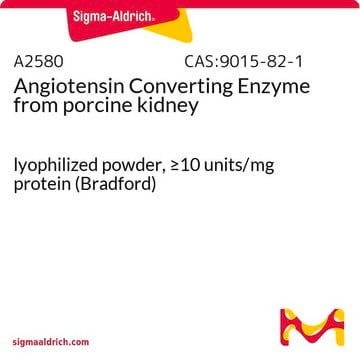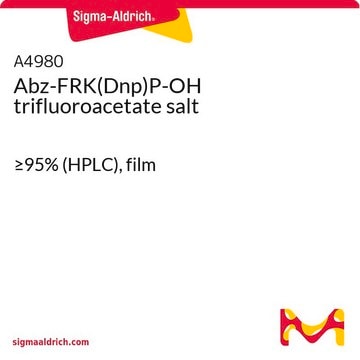The milligram quantity of this product will vary from lot to lot. The vial content is dependent upon the protein content and enzymatic activity. The minimum protein content will be 70% and the minimum activity will be 2 units per milligram protein. As an example, a batch that reports a protein content of 100% and an activity of 2 units per milligram protein will have a vial content of 2.5 mg for the 5 unit package size. The protein content and activity are reported in the product Certificate of Analysis. Please see the link below to review a sample or lot specific Certificate:
https://www.sigmaaldrich.com/product/sigma/a6778#product-documentation
A6778
Enzima conversora da angiotensina
≥2.0 units/mg protein (modified Warburg-Christian)
Sinônimo(s):
ECA, Peptidil-dipeptidase A, Peptidildipeptídeo hidrolase
About This Item
Produtos recomendados
Formulário
lyophilized powder
Nível de qualidade
atividade específica
≥2.0 units/mg protein (modified Warburg-Christian)
Condições de expedição
dry ice
temperatura de armazenamento
−20°C
Procurando produtos similares? Visita Guia de comparação de produtos
Descrição geral
Aplicação
- para mediar o efeito inibitório de hidrolisados de proteína de clara de ovo sobre a atividade da ECA por cromatografia líquida de alto desempenho (HPLC)[2]
- para medir a inibição de ECA por pericarpo de lichia[5] e peito de frango cozido[4] usando hipuril-L-histidil-L-leucina (HHL) como substrato por HPLC de fase reversa (RP-HPLC)3 e HPLC[4], respectivamente
- na liberação de proteína ancorada a GPI in vitro em algumas linhagens celulares, como HeLa, HEK293 e, in vivo, no esperma de camundongo.[1]
Ações bioquímicas/fisiológicas
Qualidade
Definição da unidade
Inibidor
substrato
Palavra indicadora
Danger
Frases de perigo
Declarações de precaução
Classificações de perigo
Resp. Sens. 1
Código de classe de armazenamento
11 - Combustible Solids
Classe de risco de água (WGK)
WGK 3
Ponto de fulgor (°F)
Not applicable
Ponto de fulgor (°C)
Not applicable
Equipamento de proteção individual
Eyeshields, Gloves, type N95 (US)
Escolha uma das versões mais recentes:
Certificados de análise (COA)
Não está vendo a versão correta?
Se precisar de uma versão específica, você pode procurar um certificado específico pelo número do lote ou da remessa.
Já possui este produto?
Encontre a documentação dos produtos que você adquiriu recentemente na biblioteca de documentos.
Os clientes também visualizaram
-
How many grams per 1 U?
1 answer-
Helpful?
-
-
What is the Department of Transportation shipping information for this product?
1 answer-
Transportation information can be found in Section 14 of the product's (M)SDS.To access the shipping information for this material, use the link on the product detail page for the product.
Helpful?
-
-
What is the effect of bleomycin on Angiotensin Converting Enzyme (ACE) activity in vivo?
1 answer-
Bleomycin causes a marked reduction in rabbit lung ACE activity. Reference: Cancer Research, 40, 3621-3626, (1980).
Helpful?
-
-
Are there any other known inhibitors of rabbit lung Angiotensin Converting Enzyme (ACE), Product A6778?
1 answer-
Idrapril, the prototype of a new class of angiotensin converting enzyme (ACE) inhibitors, competitively inhibits, with nanomolar apparent Ki, the hydrolysis of hippuryl-glycyl-glycine by rabbit lung ACE. Kinetic Ki and kon and koff values were 470 pM, 3.0±1.5×106 M-1sec-1 and 1.4±0.3×10-3 sec-1, respectively. Reference: Biochemical Pharmacology, 45(6), 1358-1362 (1993).
Helpful?
-
-
What is the medical significance of Angiotensin Converting Enzyme (ACE), Product A6778?
1 answer-
Angiotensin-converting enzyme (ACE) produces angiotensin II, a substance that affects the cardiovascular system in numerous ways, including narrowing of blood vessels. This narrowing can cause high blood pressure and cause the heart to work harder. ACE inhibitors treat a variety of conditions, such as high blood pressure, scleroderma and migraines. (Mayo Clinic)
Helpful?
-
Active Filters
Nossa equipe de cientistas tem experiência em todas as áreas de pesquisa, incluindo Life Sciences, ciência de materiais, síntese química, cromatografia, química analítica e muitas outras.
Entre em contato com a assistência técnica






![N-[3-(2-Furyl)acryloyl]-Phe-Gly-Gly](/deepweb/assets/sigmaaldrich/product/structures/225/349/530bc714-b1a8-4fdb-8082-a39329ee730a/640/530bc714-b1a8-4fdb-8082-a39329ee730a.png)







